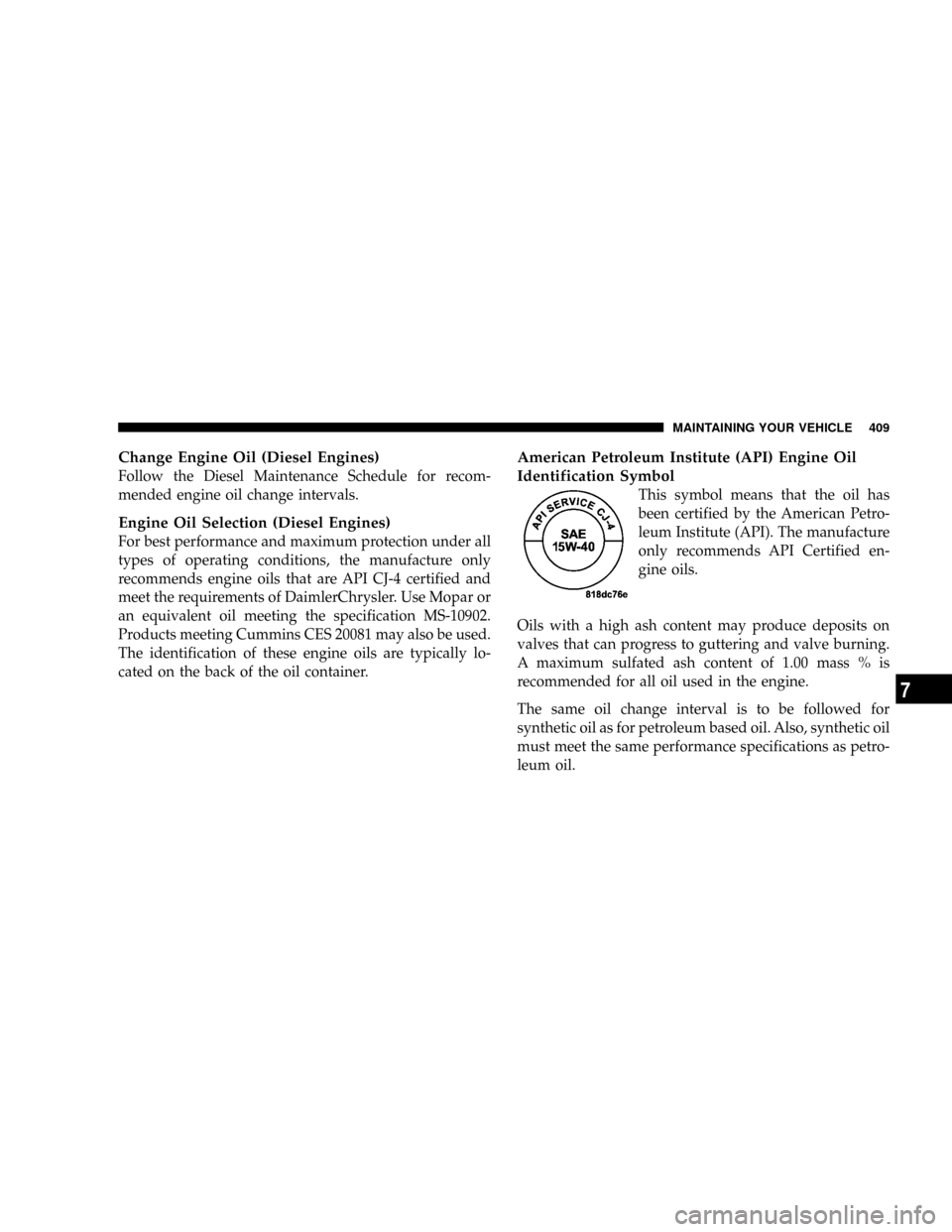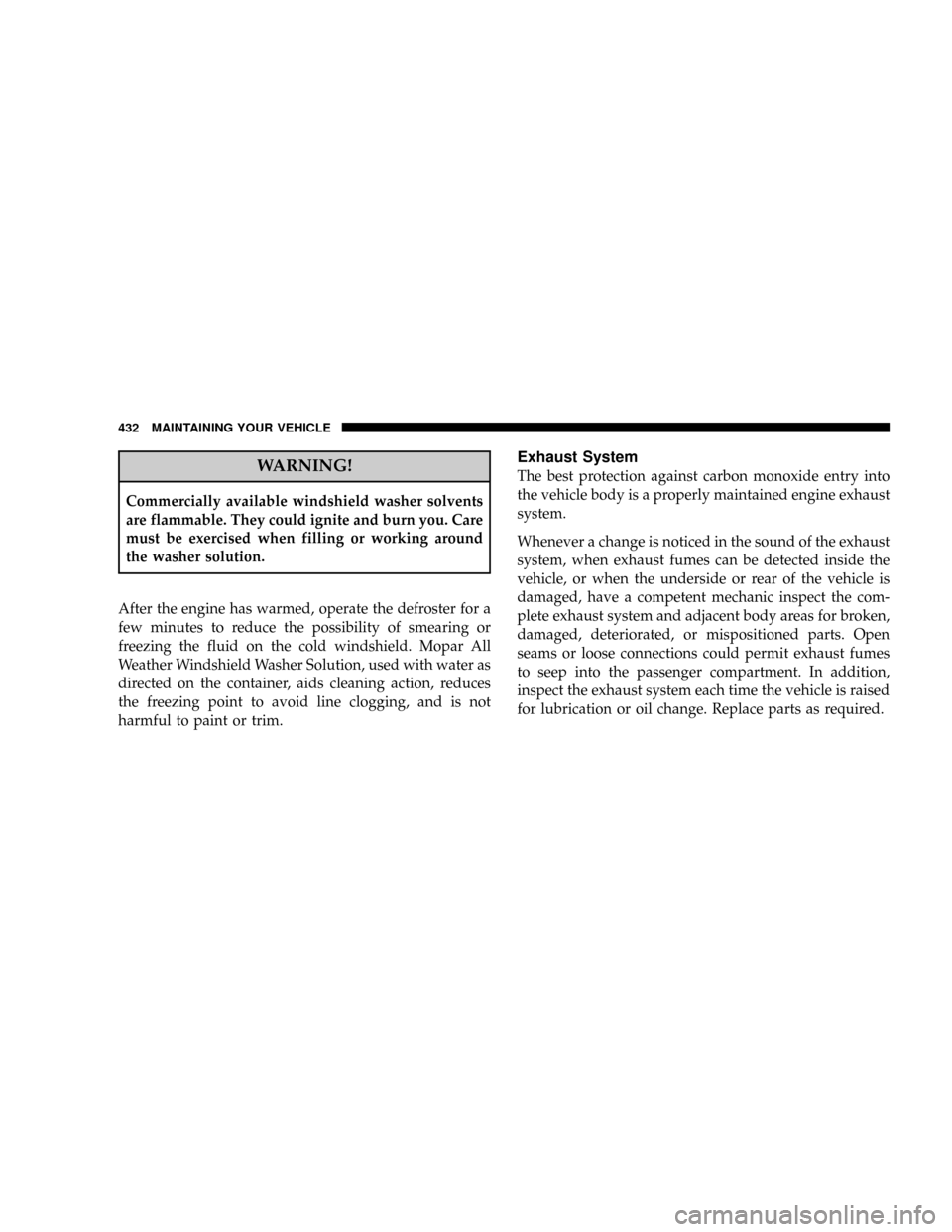Page 409 of 528

Change Engine Oil (Diesel Engines)
Follow the Diesel Maintenance Schedule for recom-
mended engine oil change intervals.
Engine Oil Selection (Diesel Engines)
For best performance and maximum protection under all
types of operating conditions, the manufacture only
recommends engine oils that are API CJ-4 certified and
meet the requirements of DaimlerChrysler. Use Mopar or
an equivalent oil meeting the specification MS-10902.
Products meeting Cummins CES 20081 may also be used.
The identification of these engine oils are typically lo-
cated on the back of the oil container.
American Petroleum Institute (API) Engine Oil
Identification Symbol
This symbol means that the oil has
been certified by the American Petro-
leum Institute (API). The manufacture
only recommends API Certified en-
gine oils.
Oils with a high ash content may produce deposits on
valves that can progress to guttering and valve burning.
A maximum sulfated ash content of 1.00 mass % is
recommended for all oil used in the engine.
The same oil change interval is to be followed for
synthetic oil as for petroleum based oil. Also, synthetic oil
must meet the same performance specifications as petro-
leum oil.
MAINTAINING YOUR VEHICLE 409
7
Page 410 of 528

Engine Oil Viscosity (SAE Grade)
Use SAE 15W-40 Engine Oil that meets
DaimlerChrysler Materials Standard MS-10902 and the
API CJ-4 engine oil category.
Engine oil not designated by the DaimlerChrysler or
Cummins Material Standards and API CJ-4 should not be
used, engine and exhaust system durability may be
compromised. For lower temperature operation SAE
5W-40 engine oils may be used. These oils must meet the
same requirements as stated previously. Your engine oil
filler cap also shows the recommended engine oil viscos-
ity for your vehicle.
Synthetic Engine Oils
You may use synthetic engine oils provided the recom-
mended oil quality requirements are met, and the recom-
mended maintenance intervals for oil and filter changes
are followed.
Materials Added to Engine Oil
The manufacture strongly recommends against the addi-
tion of any additives (other than leak detection dyes or
lube odorants) to the engine oil. Engine oil is an engi-
neered product and it's performance may be impaired by
supplemental additives.
NOTE:The manufacturer offers a lube odorant (Mopar
Diesel Fresh) for diesel engines crankcases. The lube
odorant is recommended by the manufacturer to reduce
the sulfur smell that may occur during engine idling.
Engine Oil Filter
Refer to Fluids, Lubricants and Genuine Parts for the
correct part number. The engine oil filter should be
changed ateveryengine oil change.
Engine Oil And Filter Ð Change
Operate the engine until the coolant temperature reaches
140ÉF (60ÉC). Shut the engine off. Remove the oil drain
plug.
410 MAINTAINING YOUR VEHICLE
Page 411 of 528

Use a container that can hold at least 12 quarts (11.3
Liters) to hold the used oil.
Always check the condition of the used oil. This can give
you an indication of some engine problems that might
exist.
²Thin, black oil indicates fuel dilution.
²Milky discoloration indicates coolant dilution.
Clean the area around the oil filter base. Remove the filter
from the underside of the vehicle using a cap style oil
filter wrench.
Clean the gasket surface of the filter mount. The filter
gasket can stick on the filter mount. Make sure it is
removed.
Change the engine oil filter with every engine oil change.
Only a high quality MOPAR filter should be used to
assure most efficient service.
CAUTION!
The filtering medium of other aftermarket filters
may disintegrate. Debris from failed filters may plug
the piston oil cooling nozzles, resulting in scuffed
pistons and engine failure.
CAUTION!
Fill the oil filter element with clean oil before instal-
lation. Use the same type oil that will be used in the
engine. When filling the oil filter, prevent foreign
material from falling into the filter. Severe engine
damage may occur.
Apply a light film of lubricating oil to the sealing surface
of the filter gasket before installing the filter.
MAINTAINING YOUR VEHICLE 411
7
Page 416 of 528
²If the filter is not damaged, remove all snow/ice,
reinstall filter and reset the Filter MinderŸ.
A visual inspection of the air cleaner filter element is
never recommended under normal circumstances. A
badly restricted element may appear clean while a soiled
element may be quite effective in filtering particles
without restricting air flow. Rely on the Filter MinderŸ
to determine when a filter change is necessary.
After a new filter element is inserted, press the rubber
button on the top of the Filter MinderŸ. This action will
reset the yellow disc to the clean position.CAUTION!
When using an engine cleaner or a degreaser, be sure
to wrap and tape the Filter MinderŸ to protect the
plastic housing from damage and discoloration.
CAUTION!
Many aftermarket performance air filter elements do
not adequately filter the air entering the engine. Use
of such filters can severely damage your engine.
416 MAINTAINING YOUR VEHICLE
Page 430 of 528

Front Prop Shaft Lubrication
Lubricate the front driveshaft grease fitting at each oil
change listed in the appropriate Maintenance Schedule
for your vehicle. Use Moparttype MS-6560 (lithium
based grease), or equivalent.
Front Axle Universal Drive Joints And Ball Joints
The front axle universal joint and ball joints are perma-
nently lubricated and do not require servicing.
Body Lubrication
Locks and all body pivot points, including such items as
seat tracks, doors, liftgate and hood hinges, should be
lubricated periodically to assure quiet, easy operation
and to protect against rust and wear. Prior to the appli-
cation of any lubricant, the parts concerned should be
wiped clean to remove dust and grit; after lubricating
excess oil and grease should be removed. Particular
attention should also be given to hood latching compo-
nents to insure proper function. When performing other
underhood services, the hood latch, release mechanism
and safety catch should be cleaned and lubricated.
The external lock cylinders should be lubricated twice a
year, preferably in the fall and spring. Apply a small
Front Driveshaft Grease Fitting
430 MAINTAINING YOUR VEHICLE
Page 432 of 528

WARNING!
Commercially available windshield washer solvents
are flammable. They could ignite and burn you. Care
must be exercised when filling or working around
the washer solution.
After the engine has warmed, operate the defroster for a
few minutes to reduce the possibility of smearing or
freezing the fluid on the cold windshield. Mopar All
Weather Windshield Washer Solution, used with water as
directed on the container, aids cleaning action, reduces
the freezing point to avoid line clogging, and is not
harmful to paint or trim.
Exhaust System
The best protection against carbon monoxide entry into
the vehicle body is a properly maintained engine exhaust
system.
Whenever a change is noticed in the sound of the exhaust
system, when exhaust fumes can be detected inside the
vehicle, or when the underside or rear of the vehicle is
damaged, have a competent mechanic inspect the com-
plete exhaust system and adjacent body areas for broken,
damaged, deteriorated, or mispositioned parts. Open
seams or loose connections could permit exhaust fumes
to seep into the passenger compartment. In addition,
inspect the exhaust system each time the vehicle is raised
for lubrication or oil change. Replace parts as required.
432 MAINTAINING YOUR VEHICLE
Page 441 of 528

heat and mechanical damage. Hard and brittle rubber,
cracking, tears, cuts, abrasion, and excessive swelling
indicate deterioration of the rubber. Particular attention
should be made to examining those hose surfaces nearest
to high heat sources, such as the exhaust manifold.
Insure nylon tubing in these areas has not melted or
collapsed.
Inspect all hose connections such as clamps and cou-
plings to make sure they are secure and no leaks are
present.
NOTE:Often, fluid such as oil, power steering fluid,
and brake fluid are used during assembly plant opera-
tions to facilitate the assembly of hoses to couplings.
Therefore, oil wetness at the hose-coupling area is not
necessarily an indication of leakage. Actual dripping of
hot fluid when systems are under pressure (during
vehicle operation), should be noted before hose is re-
placed based on leakage.NOTE:Inspection of brake hoses should be performed
whenever the brake system is serviced and every engine
oil change. Inspect hydraulic brake hoses for surface
cracking, scuffing, or worn spots. If there is any evidence
of cracking, scuffing, or worn spots, the hose should be
replaced immediately! Eventual deterioration of the hose
can take place resulting in a possibility of a burst failure.
WARNING!
Worn brake hoses can burst and cause brake failure.
You could have an accident. If you see any signs of
cracking, scuffing, or worn spots, have the brake
hoses replaced immediately.
MAINTAINING YOUR VEHICLE 441
7
Page 444 of 528

Drain And Refill
On 3500 vehicles the differential cover must be removed
to drain the axle fluid.
On 4500/5500 vehicles remove the lower bolt to drain the
axle fluid.Follow the appropriate Maintenance Schedule for recom-
mended front and rear axle fluid change intervals.
Lubricant Selection
Refer to Fluids, Lubricants and Genuine Parts for the
correct lubricant type.
NOTE:The presence of water in the gear lubricant will
result in corrosion and possible failure of differential
components. Operation of the vehicle in water, as may be
encountered in some off-highway types of service, will
require draining and refilling the axle to avoid damage.
Limited-Slip Differentials DO NOT REQUIREany
limited slip oil additive (friction modifiers).
NOTE:Slight noise and mild shuddering may be evi-
dent while turning a vehicle with limited slip differential
on concrete or dry pavement. These conditions should be
considered normal operation of the limited slip differen-
tial.
1 Ð 4500/5500 Rear Axle Fluid Fill Plug
2 Ð 4500/5500 Rear Axle Fluid Drain Plug 444 MAINTAINING YOUR VEHICLE